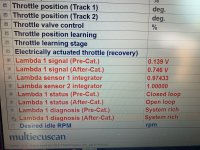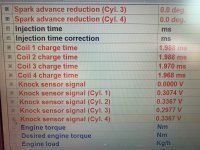I've got a lumpy tickover. I've had cambelt done and changed spark plugs. I'm not sure that it was doing this before or not as I had only driven it to the paint shop and back. It drives fine and the lumpyness is less when the engine is warm.
It's also sometimes taking two turns of the key to start it.
No errors anywhere on the dash or on MES.
Readings on MES on the engine while it's running show that the pre-cat lambda has a closed loop and the post cat has an open loop. This has been like this at cold start and when normal running temperature.
Knock sensor also shows 0.0V. Would this be right?
System is shown rich on both Lambda's in the attached picture but this was just after starting. Now it's at temperature, pre-cat is showing lean but post cat is showing rich. Am I right in thinking this isn't right?
Would appreciate any help.
It's also sometimes taking two turns of the key to start it.
No errors anywhere on the dash or on MES.
Readings on MES on the engine while it's running show that the pre-cat lambda has a closed loop and the post cat has an open loop. This has been like this at cold start and when normal running temperature.
Knock sensor also shows 0.0V. Would this be right?
System is shown rich on both Lambda's in the attached picture but this was just after starting. Now it's at temperature, pre-cat is showing lean but post cat is showing rich. Am I right in thinking this isn't right?
Would appreciate any help.



